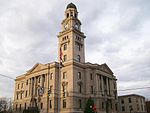W. P. Snyder Jr. (towboat)
Museum ships in OhioNational Historic Landmarks in OhioNational Register of Historic Places in Washington County, OhioShips on the National Register of Historic Places in OhioSteamboats of the United States ... and 3 more
Tourist attractions in Washington County, OhioTugboats of the United StatesUse mdy dates from August 2023

W. P. Snyder Jr., also known as W. H. Clingerman, W. P. Snyder Jr. State Memorial, or J. L. Perry, is a historic towboat moored on the Muskingum River in Marietta, Ohio, at the Ohio River Museum. A National Historic Landmark, she is the only intact, steam-driven sternwheel towboat still on the nation's river system.
Excerpt from the Wikipedia article W. P. Snyder Jr. (towboat) (License: CC BY-SA 3.0, Authors, Images).W. P. Snyder Jr. (towboat)
River Trail,
Geographical coordinates (GPS) Address External links Nearby Places Show on map
Geographical coordinates (GPS)
| Latitude | Longitude |
|---|---|
| N 39.420277777778 ° | E -81.463333333333 ° |
Address
W. P. Snyder Jr.
River Trail
45750 , Harmar
Ohio, United States
Open on Google Maps











